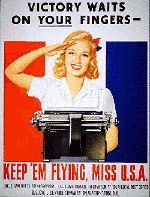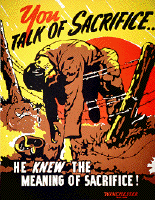January 1, 1943
Examiner launched the "Save a Life With a Knife" campaign and urged
readers with sturdy hunting knives, with blades at least four-inches
long, to bring them to campaign headquarters at 1025 Columbus Ave., or
to the Examiner Want Ad Lobby at Third and Market sts. The knives were
to be shipped to the jungle fighting fronts by airplane.
January 17, 1943
Tin Can Drive Day for scrap metal.
January 26, 1943
Japanese aircraft strafed Costantine Harbor on Amchitka Island in the
Aleutians.
January 30, 1943
B-17 crew attacks unidentifed submerged object in Alaskan waters, and
dropped four depth charges and one bomb. The unidentified object was a
whale.
February 1, 1943
Three hundred soldiers appear in Irving Berlin's "This is the Army," at the Opera House. Personal appearance by Irving Berlin. Proceeds to the Army's Relief Fund. National tour of the revue closes Feb. 13 at the War Memorial.
Mayor Rossi has asked San Francisco hotels to provide more sleeping space for soldiers by putting cots in dining rooms and ballrooms.
February 4, 1943
American P-40's strafed Japanese installations on the island of Kiska. Five
enemy bombers attacked American positions on Amchitka.
February 9, 1943
Roland Hayes in performance at Veterans Auditorium. Proceeds for release and rehabilitation of anti-Fascist fighters. Sponsored by the Joint Anti-Fascist Refugee Committee.
February 16, 1943
James Waterman Wise speaks of "The Jew in a Warring World," at the Jewish Community Center.
February 20, 1943
"Tribute to George Gershwin" at the Civic Auditorium with the San Francisco Symphony. Paul Whiteman and his orchestra, Bing Crosby and Dinah Shore. Majority of tickets are set aside for military personnel.
February 28, 1943
Life Magazine photographer William Vandivert's "Two Years of War in England" exhibition closes at the San Francisco Museum of Art, Civic Center.
Mai-Mai Sze, daughter of the former Chinese ambassador to the U.S., discusses "The Future of China" at the Curran Theatre. A luncheon-reception followed at the Hotel Clift Roof Lounge.
March 3, 1943
Adm. Thomas C. Kincaid, commanding officer of the Alaska Defense
Command, begins planning for the invasion of Attu.
March 5, 1943
Pepsi-Cola Center, 948 Market Street, opened for servicemen.
March 25, 1943
Mme. Chaing Kai-shek welcomed by members of the Chinese Six
Companies in Chinatown.
March 26, 1943
Navy engaged the Japanese in the Battle of Komandorskies, 150 miles west
of Cape Wrangell, Alaska. B-25 Mitchell Bombers attacked Japanese
positions on Kiska.
 March 27, 1943
March 27, 1943
Mme. Chaing Kai-shek address at the Civic Auditorium where she spoke of
the task of the Home Front to ensure ideals of justice and freedom.
Addresses by Gov. Warren, Mayor Rossi and Dr. Robert Gordon Sproul of
the University of California.
March 29, 1943
Charlotte, Grand Duchess of Luxembourg, visited.
April 1, 1943
Gen. DeWitt orders preparations for Operation Landgrab, the invasion of
Attu Island. American planes strike Japanese targets on Kiska.
April 14, 1943
United States War Food Administration, Office of Distribution, regional
poultry and egg conference in San Francisco.
May 2, 1943
Civilian Defense held the first Water Evacuation Drill for 1500 wardens at
the foot of Van Ness Ave.
May 7, 1943
U.S. Senate adopted Senate Resolutions 101 and 111 authorizing the
Committee on Military Affairs or any subcommittee thereof to visit
Japanese Relocation Centers in the United States.
May 11, 1943
Attu and Kiska in Aleutian Islands were retaken by a military expedition
launched from San Francisco. The campaign lasted until May 30.
May 27, 1943
U.S. Senate Committee on Naval Affairs hearing on the Navy's current and
prospective occupancy of Treasure Island.
May 30, 1943
All organized Japanese Army resistance ended in the Aleutians.
May 30, 1943
Dies Committee on Un-American Activities reported that 40,000
Japanese are still at large in the U.S. and an uncertain number were trained
in Japan as saboteurs. The committee also criticized the War Relocation
Authority for releasing 1000 Japanese per week from relocation camps.
June 8, 1943
Civil Defense officials began V-Home
Campaign because of the continued possibity of enemy attack. The
objective was to award "V-Home, We Are Prepared" stickers to qualified
households. These stickers were made available by the United States Office
of Civilian Defense as part of a national campaign which is already
underway.
June 17, 1943
Liberty ship "Fremont Older" launched today at Richmond Shipyard No. 2. San Francisco attorney John Francis Neylan was a speaker at the launch ceremonies. Cora Older, widow of the newspaper editor, launched the new Liberty ship.
July 3, 1943
When it is necessary for a Civilian Defense Warden to enforce blackout
regulations by unusual action - such as breaking a window, gaining
entrance to a building, or other such occurrence, or in the event of an
injury to a Warden in the performance of his duty, the Sector Warden was
to, immediately after the "All Clear," telephone the incident to the
Battalion Headquarters in his district giving the name and address of the
violator as well as a description of the violation and action taken.
 July 29, 1943
July 29, 1943
Office of Civilian Defense, at Washington, D. C., ordered Fire Guard
watches in San Francisco because of the fear of Japanese incendiary bomb
raids.
August 2, 1943
Civilian Defense officials established War Gas Self-Aid Stations in San
Francisco in preparation for gas attacks by the Japanese. Chief Civilian
Defense Warden Eugene Broderick said, "It is imperative that the people of
San Francisco be familiar with war gas self-aid; and that there be
adequate facilities available to those who may be exposed to war gas
contamination. Fortunately, these facilities are common to almost every
home, and in many homes are so conveniently located as to be also readily
available -- if the householder is willing -- for public use."
August 10, 1943
Paul Robeson sang at a concert honoring the United Nations at the Civic
Auditorium, with Albert Coates guest conducting the San Francisco
Symphony Orchestra. Concert sponsored by the CIO.
August 18, 1943
Construction began on barracks for servicemen in Civic Center.
September 9, 1943
Roy Rogers, King of the Cowboys, and his horse Trigger, appeared in
the Admission Day Parade on Market St.
September 27, 1943
Volunteer Defense Corps gas officers held maneuvers at the Presidio. As
part of the exercise, the volunteers used newly developed chemical detector
kits and posted warning signs.
October 4, 1943
Fire Chief Albert J. Sullivan urged people to keep war materials safe from
fire as he launched Fire Prevention Week. The chief said, "It is a patriotic
duty we must observe to do everything possible to prevent such losses by
cleaning up every potential fire hazard and practicing extreme caution."
November 1, 1943
Dimout order lifted.
November 21, 1943
Dies Committee found that the Japanese internment camp at Rivers Camp, Arizona was not well-
run, and the Japanese there are in control. Land for the internment
camp had been leased to the Government by the Pima Indian tribe.
Undercover investigators found bootleggers selling liquor there at $6 per
pint, and that Caucasian employees were chummy with the Japanese.
November 24, 1943
Leopold Stokowski conducted all-Russian Program with the San
Francisco Symphony.
Go to 1944 Exhibit.